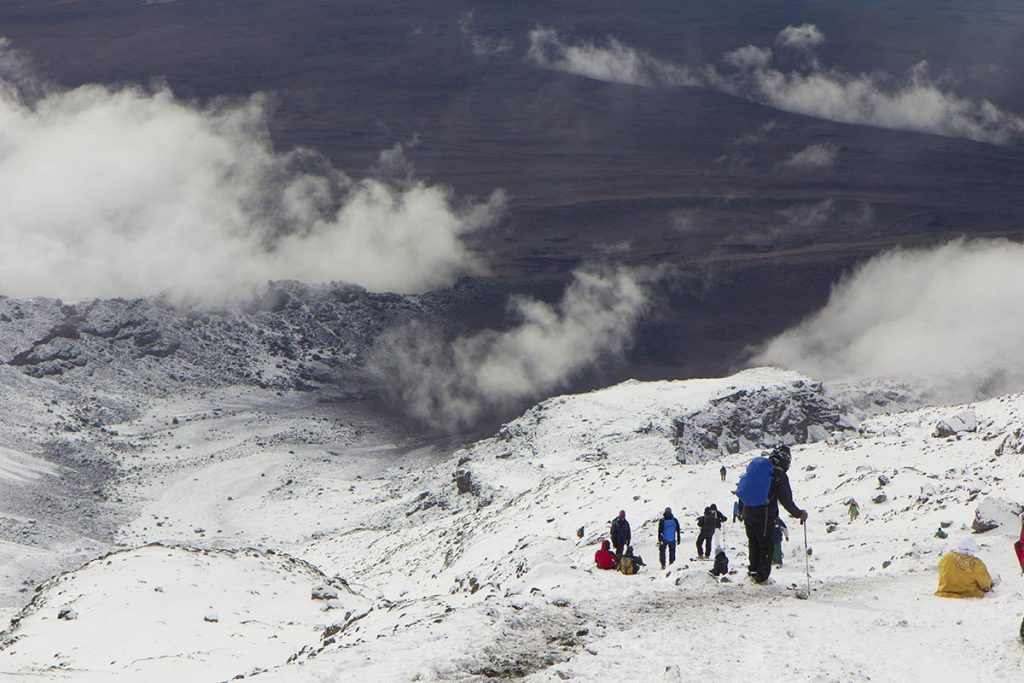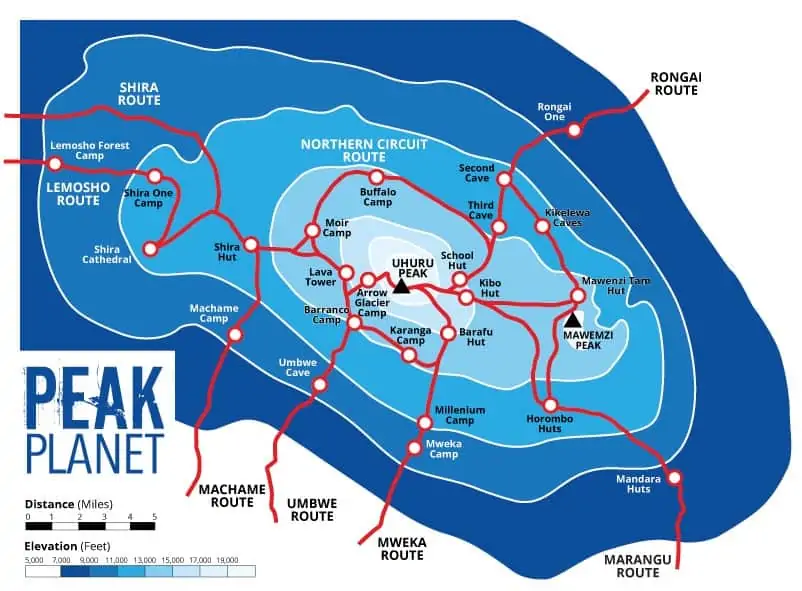Every year thousands of people make their way to Africa with the intention to summit Africa’s tallest mountain.
But many of them never make it to the peak.
Why?
In this article we explain how difficult it is to climb Kilimanjaro, the main reasons people do not reach the summit, and how to improve your chances.
 Route Choice
Route Choice
It is often stated that half the people who attempt to climb Kilimanjaro fail.
Whether this holds true is debatable because the park authorities do not release summit success statistics. Therefore, the rate of success has to be estimated based on our own guiding experience plus what we can gather from our competitors. We believe that almost certainly more than 50% of climbers summit. While the rate of failure may have been higher in the past, improvements to the way we as an industry climb today have increased the summit success rate.
Years ago, there was only one choice when it came to the route – Marangu.

As far as routes are concerned, Marangu is a tough one despite what you may have read.
The first person to climb Kilimanjaro was German geologist Hans Meyer. He finally made it to the top on his third try in 1889, back when the mountain was covered in ice. Fast forward to the 1960’s, when commercial operations began to flourish. Marangu more or less was the original path that Meyer took during his three expeditions. Huts were erected by the East African Mountain Club along the path to make the journey more comfortable. The Tanzanian government took over management of the mountain in 1973 and formed the national park.
The Marangu route is one of the shortest routes on the mountain, five days. The success rate of climbing Kilimanjaro is highly correlated to the number of days spent on the mountain. Many people are unable to acclimatize to the altitude sufficiently in just five days and thus succumb to altitude sickness during the ascent.
The Machame route was the second commercial route on the mountain. The mere fact that it was a six day route improved the success rate. Additionally, the route profile included some “climb high, sleep low” days that boosted acclimatization.
For a long time, these were the only two routes that people used to climb Kilimanjaro. This is likely when the 50% success rate became well popularized as climbing five and six day routes, even today, yields a similar success rate overall.
 Now there are more options and better routes up Mount Kilimanjaro. So while we still have people climbing the five day Marangu and six day Machame routes, many people opt for longer seven, eight and nine day routes that significantly increase the success rate of the mountain as a whole.
Now there are more options and better routes up Mount Kilimanjaro. So while we still have people climbing the five day Marangu and six day Machame routes, many people opt for longer seven, eight and nine day routes that significantly increase the success rate of the mountain as a whole.
We estimate that an eight-day trek has around a 90% success rate. For every day less on the mountain the success rate decreases by 20%. So for a 7 day climb the success rate is 70%. For 6 days it is 50%. For five days, just 30%.
The availability and growing popularity of longer Kilimanjaro routes dramatically increased the overall success rate of those climbing the mountain.
We highly recommend selecting the longest route possible. It is the single most important thing you can do to improve your chances of summiting.
Training
Because Mount Kilimanjaro is a “walkable” mountain, meaning you do not need any technical skills, some people tend to underestimate it. However, the elevation change is significant and the peak is extremely high at 19,341 feet. This means that your body will be deprived of the oxygen as you climb higher and higher, as the path becomes steeper and steeper. Your body will be forced to adapt to this challenging environment.
One way to improve your body’s response is to train hard. Try to hike in the mountains as often as you can before your climb dates. If you don’t live in an area where mountains are accessible, climb stairs or go to the gym and walk on a stairclimber. Endurance is key, not power.
By having long training sessions, your legs will become accustomed to extended periods of use and recovery. Taxing your cardiovascular system will also improve oxygen efficiency. Both of these factors are important on Mount Kilimanjaro.
The better your physical and cardiovascular fitness is with respect to hiking, the easier the climb will be. Do not believe that your talent in other sports will translate directly to climbing Kilimanjaro. For instance, while a marathon runner, tennis player or weightlifter might be in a better starting place than a couch potato when it comes to training, we contend that everyone still needs to train in a manner that simulates hiking in order to be most effective.
Here is our recommended workout schedule: https://peakplanet.com/climb-preparation/#train
We highly recommend selecting the longest route possible. It is the single most important thing you can do to improve your chances of summiting.
Personal Oxygen Systems
The use of a personal oxygen system greatly reduces the difficulty of climbing Kilimanjaro.
 Given that failure to acclimatize to the altitude is the main reason why people fail on Kilimanjaro, it would make sense that incorporating an oxygen system reduces the difficulty of climbing the mountain.
Given that failure to acclimatize to the altitude is the main reason why people fail on Kilimanjaro, it would make sense that incorporating an oxygen system reduces the difficulty of climbing the mountain.
ALTOX Personal Oxygen Systems provide supplementary oxygen to a climber during the final ascent. The system includes an oxygen cannister connect to a nasal cannula that sits under the nostrils. When its pulse meter detects an inhalation, it delivers a burst of oxygen. This added oxygen enables to perform at a higher level in an oxygen-deprived environment, boosting strength, endurance and recovery. And just as importantly, it can eliminate most if not all of the symptoms of altitude sickness.
Education
Another reason people fail at their summit attempt is their lack of knowledge about the climb. It’s hard for a person to prepare if he or she does not know the details around what they are preparing for. Some people arrive on the wrong dates, with the wrong gear, with training and without medications. Being carefree or naive about a high altitude trek is a recipe for disaster.
We don’t want any surprises on the mountain.
Put in the effort to learn as much as you can about climbing Kilimanjaro. Read this website, personal blogs, news articles, and message boards.
One question we get all the time is “What else do I need to know?” That’s an impossible question to answer. Educate yourself then write down a list of questions to ask. We can fill in the blanks but we can’t write the entire novel.
Frequently asked questions can be found here: https://peakplanet.com/faqs/




